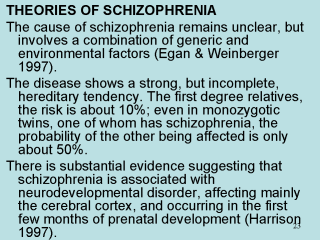| front |1 |2 |3 |4 |5 |6 |7 |8 |9 |10 |11 |12 |13 |14 |15 |16 |17 |18 |19 |20 |21 |22 |23 |24 |25 |26 |27 |28 |review |
 |
Brain imaging in
chronic schizophrenia shows cortical atrophy, with enlargement of the cerebral ventricles.
This was originally ascribed to progressive neurodegeneraton, but it was later shown to be
present in preschizophrenic subjects, and not to be progressive. Studies of post-mortem schizophrenic brains show evidence of misplaced cortical neurons with abnormal morphology, suggestive of defective cell migration during early development. Additional evidence suggests that environmental factors such as maternal virus infections during pregnancy, may contribute schizophrenia is therefore now viewed as a neurodevelopmental, rather than a neurodegenerative, disorder. Psychological factors, such as stress, may precipitate acute episodes, but are not the underlying cause. The search of neurochemical abnormalities in schizophrenia has been unsuccessful for many years. Thought it was hoped that a neurochemical theory would provide the basis for rational drug treatment, the opposite has occurred: drugs found by chance to be effective have provided the main clues about the nature of the disorder. |